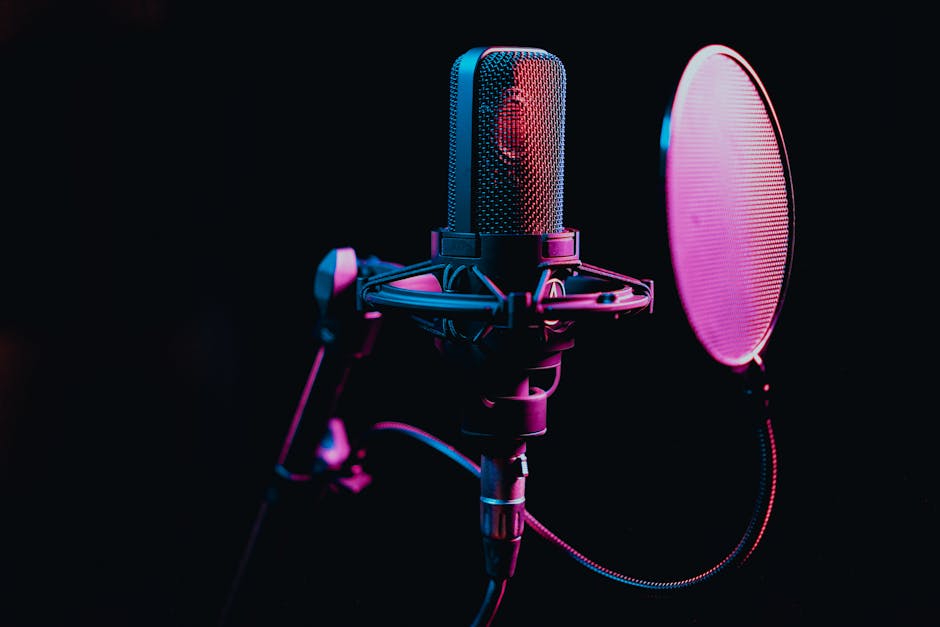My Guide to Choosing the Right Bitrate for Podcast Audio.
My Guide to Choosing the Right Bitrate for Podcast Audio
As a podcaster, you pour your heart into every episode – crafting compelling narratives, conducting insightful interviews, and delivering valuable content. But even the most brilliant audio can fall flat if the technical foundations aren’t solid. One of the most crucial, yet often overlooked, aspects of podcast production is choosing the right bitrate for your audio. It’s a number that directly impacts how your podcast sounds to your listeners and how easily they can access it.
Think of bitrate as the digital data flow of your audio. Too low, and your carefully recorded voice might sound muddy or tinny. Too high, and your listeners could face buffering issues, or you might struggle with excessive file sizes and hosting costs. My goal with this guide is to demystify bitrate and empower you to make an informed decision that elevates your podcast’s audio experience, ensuring your message is heard exactly as you intend.
Decoding Bitrate: Why This Number Shapes Your Podcast’s Sound
Before we dive into selection, let’s clarify what bitrate actually is. In simple terms, bitrate refers to the number of bits per second that are transmitted or processed in a digital audio stream. It’s measured in kilobits per second (kbps). The higher the bitrate, the more data is used to represent the audio, resulting in a higher fidelity sound. Conversely, a lower bitrate means less data, leading to a smaller file size but potentially a noticeable drop in audio quality.
For podcasts, we’re primarily dealing with compressed audio formats like MP3 or AAC. These formats use algorithms to remove information that the human ear is less likely to perceive, making the file size smaller without (ideally) a significant loss in perceived quality. Bitrate dictates how aggressively this compression is applied. A higher bitrate preserves more of the original audio information, leading to a richer, clearer, and more dynamic sound. A lower bitrate strips away more, which can introduce artifacts, reduce clarity, and flatten the audio’s dynamic range. Understanding this fundamental trade-off between quality and file size is the first step in making a smart bitrate choice for your podcast.
Constant Bitrate (CBR) vs. Variable Bitrate (VBR): A Quick Distinction
- Constant Bitrate (CBR): This method maintains a consistent bitrate throughout the entire audio file. It’s predictable, making file size estimation easy and ensuring broad compatibility across devices and platforms. Many podcast hosting services recommend CBR for simplicity and reliability.
- Variable Bitrate (VBR): VBR adjusts the bitrate dynamically based on the complexity of the audio content. Quieter, less complex sections use a lower bitrate, while busy, dynamic sections use a higher bitrate. This can lead to smaller file sizes for comparable quality, but some older players or specific streaming scenarios might encounter issues. For most podcasters, especially those starting out, CBR is often the safer and more widely accepted choice.
Balancing Act: Key Factors Influencing Your Podcast Bitrate Decision
Choosing the “right” bitrate isn’t a one-size-fits-all answer. It’s a strategic decision based on several critical factors unique to your podcast. Neglecting these can lead to frustrated listeners or unnecessary production overheads.
The Nature of Your Podcast Content
What kind of audio are you primarily producing? This is perhaps the most significant factor:

- Speech-Only Podcasts: If your show is predominantly conversational, interviews, or solo narration with minimal music or sound effects, you can often get away with a lower bitrate without sacrificing much perceived quality. The human voice has a relatively narrow frequency range compared to complex music.
- Music-Heavy Podcasts: If your podcast features a lot of music, intricate soundscapes, or full band performances, you’ll need a higher bitrate. Music contains a much wider range of frequencies and dynamics that are more susceptible to noticeable degradation at lower bitrates.
- Podcasts with Rich Sound Design: Shows that heavily rely on immersive sound effects, ambient beds, or dramatic scores will also benefit from a higher bitrate to ensure all those subtle layers and nuances are preserved.
Your Target Audience and Their Listening Habits
Consider how and where your audience consumes your podcast:
- Mobile Listeners on Data Plans: A significant portion of podcast listening happens on mobile devices, often on cellular data. Higher bitrates mean larger file sizes, which consume more data and take longer to download or stream. This can be a deterrent for listeners with limited data plans or slow connections.
- Listeners in High-Bandwidth Environments: If your audience primarily listens via Wi-Fi or high-speed broadband, the impact of a larger file size is less critical, allowing you more leeway for higher quality.
- Audiophiles vs. Casual Listeners: While some listeners might appreciate pristine audio, the vast majority prioritize accessibility and a clear, understandable presentation over studio-grade fidelity. Don’t over-optimize for a tiny segment of your audience if it negatively impacts the broader base.
Podcast Hosting Platform and Distribution Requirements
Most podcast hosting platforms have recommended or even mandatory audio specifications. For instance, Apple Podcasts requirements are often considered the industry standard, and many platforms align with them. Check your chosen host (e.g., Libsyn, Buzzsprout, Anchor) for their specific guidelines. They often provide helpful Libsyn’s audio recommendations to ensure optimal delivery.
Mono vs. Stereo Recording
This is a fundamental choice that impacts bitrate needs:
- Mono (Monaural): All audio information is contained within a single channel. This is perfectly adequate for most speech-based podcasts and results in smaller file sizes for a given bitrate compared to stereo.
- Stereo (Stereophonic): Audio information is split into two distinct channels (left and right), creating a sense of space and directionality. This is essential for music, immersive sound design, or podcasts where spatial audio cues are important. A stereo file at the same bitrate as a mono file will typically have half the effective quality per channel because the data is split. Therefore, stereo usually requires a higher bitrate to maintain comparable quality per channel.
For most conversational podcasts, mono is perfectly acceptable and efficient. If you have music or complex sound effects, stereo might be preferred, but be prepared to use a higher bitrate to compensate.
Navigating the Numbers: Standard Bitrates and What They Mean for Your Show
Let’s look at common bitrates used for podcasting and what they typically deliver in terms of quality and file size. Remember, these are general guidelines, and your ears are the ultimate judge.
Common Bitrate Choices for Podcast Audio (MP3/AAC)
- 64 kbps (Mono): This is often considered the minimum acceptable bitrate for speech-only podcasts, especially if you prioritize extremely small file sizes and bandwidth efficiency. Quality can be acceptable for clear dialogue, but music will suffer noticeably. It’s often used for voice notes or very compressed audio.
- 96 kbps (Mono or Stereo): A popular choice for speech-focused podcasts. At 96 kbps mono, you get very good speech clarity and a decent file size. If used for stereo, the quality per channel drops, making it less ideal for music but still passable for simple sound effects or background music.
- 128 kbps (Mono or Stereo): This is arguably the sweet spot for many podcasts.
- 128 kbps Mono: Excellent speech quality, often indistinguishable from higher bitrates for voice, with a very manageable file size. Highly recommended for most speech-driven podcasts.
- 128 kbps Stereo: Good quality for speech and acceptable for music, though discerning listeners might notice some compression artifacts in complex musical passages. It’s a widely compatible and generally robust choice for mixed content.
- 192 kbps (Stereo): A high-quality option, particularly recommended for podcasts that heavily feature music, detailed sound design, or have an audiophile audience. At this bitrate, music sounds rich and full, and speech is pristine. The trade-off is significantly larger file sizes, which can impact download times and hosting costs.
- 256 kbps and Above (Stereo): While these bitrates offer near-CD quality, they are often overkill for podcasts. The difference in perceived quality over 192 kbps is marginal for most listeners, especially given the typical listening environments (headphones, car speakers, phone speakers). The file size increase is substantial, making it impractical for most podcast distribution.
Recommendation: For most speech-based podcasts, 128 kbps mono is an excellent balance of quality and file size. For podcasts with significant music or sound design, 128 kbps stereo or even 192 kbps stereo will provide a superior listener experience.
Crafting Your Audio Signature: A Step-by-Step Approach to Bitrate Selection
Now that you understand the variables, let’s put it into practice. Here’s a practical framework for choosing the right bitrate for your podcast.
Step 1: Assess Your Podcast’s Content Profile
Be honest about what your podcast primarily features. Is it:
- 90% talking heads, 10% intro/outro music? (Lean towards lower bitrates, mono)
- 50% interviews, 50% curated music or field recordings? (Consider higher bitrates, stereo)
- A full-blown audio drama with intricate soundscapes? (Definitely higher bitrates, stereo)
This assessment will immediately narrow down your options.
Step 2: Understand Your Audience’s Consumption Habits
Where and how do your listeners tune in? If analytics show a high percentage of mobile listeners on cellular data, leaning towards a more efficient bitrate might be wise. If your show is niche and caters to high-fidelity audio enthusiasts, you might opt for higher quality.




Post Comment